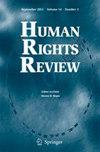人权法与减少温室气体排放的义务
IF 1.3
Q1 LAW
引用次数: 1
摘要
人们呼吁人权法来帮助解决温室气体持续高排放的问题。据称,国家和其他法律实体降低排放(缓解)的义务可以从该法律体系中推导出来。我反驳这一论点。首先,我考虑了原告面临的两个实际困难——因果关系和非琐碎性,原告以减少排放为目标,试图使用常规的侵权举证模式来证明侵犯人权。对缓解采取"人权办法"的支持者认为,证明被告的排放"贡献"以及气候变化对原告人权的"影响"足以免除证明因果关系的举证责任。其余的因果链只是简单的假设。这样,侵犯人权的原始证明模式就被抛弃了。对于琐碎性难题,支持者的答案是将排放者聚集成非常大的实体,并对它们提起诉讼。然而,聚合可以被证明会导致还原法和谬论。在我的论点的第二部分中,我指出了以人权方式解决缓解问题的一个更根本的困难:被告的排放并不构成违反规范的行为。在没有立法或其他禁止的情况下,每个人都在排放。关于气候变化的条约法律本身承认排放行为是合法的,并允许至少在2050年之前继续国家排放。根据《巴黎气候变化协定》的预算,全球变暖将从工业化前的水平上升至1.5摄氏度,并有可能进一步上升至接近2摄氏度。预算的制定肯定了预算内排放的常态化地位。这种普遍许可排放的做法否定了人权的缓解办法,也否定了适用人权法的条件。本文章由计算机程序翻译,如有差异,请以英文原文为准。
Human Rights Law and the Obligation to Reduce Greenhouse Gas Emissions
Human rights law has been called upon to help with the problem of persistently high greenhouse gas emissions. An obligation on states and other legal entities to lower their emissions (mitigation) is said to be deducible from that body of law. I refute this thesis. First, I consider two practical difficulties—causality and non-triviality—that face a plaintiff who, with emission mitigation as the objective, attempts to prove a human rights violation using the regular pattern of proof for a violation. Proponents of the “human rights approach” to mitigation have held that proof of an emission “contribution” by the defendant together with proof of an “impact” by climate change on the plaintiff’s human rights are sufficient to discharge the evidentiary burden for the proof of causation. The rest of the causation chain is simply presumed. Thus, the original proof pattern for a human rights violation is abandoned. The proponents’ answer to the triviality difficulty has been to aggregate emitters into very large entities and sue them . However, aggregation can be shown to lead to a reductio ad absurdum . In my argument’s second part, I identify a more fundamental difficulty with the human rights approach to mitigation: The defendant’s emissions do not amount to a norm violation. Everyone contributes emissions without legislative or other prohibition. Treaty law on climate change itself recognizes emitting behaviour as lawful and permits the continuation of state emissions through to at least 2050. A rise in global warming from preindustrial levels to 1.5° Celsius with room for an even greater rise to close to 2° Celsius has been budgeted for by the Paris Agreement on Climate Change. The setting up of a budget affirms the normalized status of within-budget emissions. This universal license to emit denies the human rights approach to mitigation the very conditions of application of human rights law.
求助全文
通过发布文献求助,成功后即可免费获取论文全文。
去求助
来源期刊

Human Rights Review
LAW-
CiteScore
2.70
自引率
14.30%
发文量
22
期刊介绍:
Human Rights Review is an interdisciplinary journal which provides a scholarly forum in which human rights issues and their underlying empirical, theoretical and philosophical foundations are explored. The journal seeks to place human rights practices and policies within a theoretical perspective in order to link empirical research to broader human rights issues. Human Rights Review welcomes submissions from all academic areas in order to foster a wide-ranging dialogue on issues of concern to both the academic and the policy-making communities. The journal is receptive to submissions drawing from diverse methodologies and approaches including case studies, quantitative analysis, legal scholarship and philosophical discourse in order to provide a comprehensive discussion concerning human rights issues.
 求助内容:
求助内容: 应助结果提醒方式:
应助结果提醒方式:


